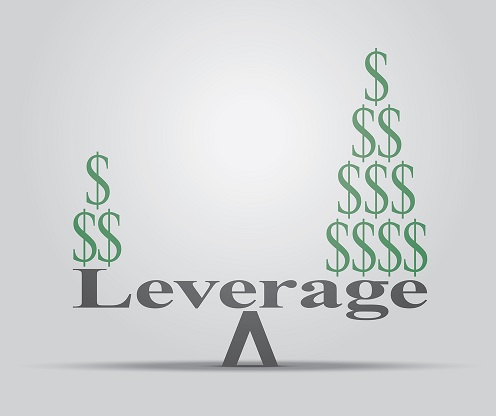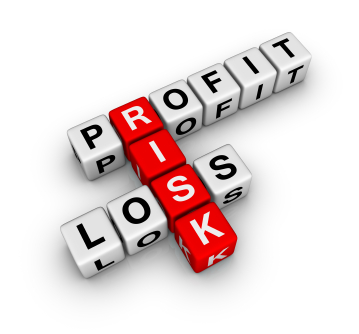Leverage is the force in trading that enables traders to take exposure to artificially amplified transaction sizes, in order to make more money from each individual transaction. Imagine the scenario where you’re buying shares, with a view to becoming a professional share dealer. Without a massive amount of starting capital, it’s likely to take you some time before you’re in a position to generate anywhere near a full-time income. Markets simply don’t move enough in the day to make that feasible for those with less than 6-figure capital amounts to play with.
Leverage, however, makes up the difference on individual trades, which in turn makes it easier for traders to take a profit. Naturally, as with anything with the potential to return substantial gains, increasing the leverage portion of any transaction also makes things a whole lot riskier, and the difficulties leverage can pose when it starts to work against you are vast.
How Does Leverage Work?

Instead of transacting at 100% of your exposed capital, as is always the case when trading 1:1, leverage enables trading at many thousands of percent of your exposed capital, on the proviso that you return the leveraged portion when the transaction closes. Don’t worry – this is automatic. This effectively means you get to keep the earnings on thousands of pounds for every $100 you actually risk. While the losses are correspondingly significant, the effect of leverage is to effectively up the ante, and in the process it works extremely efficiently.
Leverage And Forex
In forex trading, the degrees of leverage on offer put other instruments to shame. Whereas some derivatives may offer around 20:1 leverage, forex can be traded with rations in the hundreds to one, and as a result leverage is arguably more central to forex trading than to other instruments. With other products, the markets traded are usually sufficiently volatile to make smaller degrees of leverage more workable. However, given the greater magnitude of factors required to shift currency pricing, the need for higher degrees of leverage is even greater in order to help traders grind out a return. That said, the extent of leverage at play in forex is enough to have helped countless traders both find and lose their fortunes in the global currency markets.
So leverage is a term you’re likely to come across on a frequent basis throughout this tutorial and elsewhere. To summarise its importance, leverage is the magnifying glass that makes your positions appear bigger than they are to enable larger earnings than would otherwise be possible. While this naturally means a more expansive risk profile, when used correctly it can be the forex trader’s best friend.
Advantages of Leverage in Forex
When it comes to really upping the stakes with forex, it’s leverage that is capable of doing the most damage. By blowing up position sizes to beyond where they naturally ought to be, leverage equips traders with facilities that mimic the effect of risking more capital, and this delivers a whole host of benefits and advantages to those traders capable of taming the wild beast that leverage can be. But what exactly are these key advantages, and how do they intersect to make leverage worthwhile for forex traders?
Increase Profit
The first and by some way most important benefit of trading on leverage is that it earns you more money for less effort. No matter what the instrument that’s being traded, no matter whether you’re staking a small amount or a large amount, the key role of leverage is to increase your profit from each available transaction by multiplying the stakes. The same effect could be achieved by investing more capital in each position, but leverage works to ensure it’s always one step ahead in artificially boosting your available capital – often by many hundreds of times.
No matter the intricacies and the finer points of why leverage matters, don’t let anyone tell you that leverage plays a different role for them – primarily, it’s all about making more money for the same research work and simply raising the stakes without tying up more of your precious capital.
Increase Capital Efficiency
At the same time, increasing the amount of money you can earn per transaction naturally increases the efficiency with which you are using your capital. To get all technical for a moment, consider your capital as an asset with the ability to deliver a yield. If it takes you two days to generate a $100 with unleveraged positions, leveraging up will mean it takes a much shorter period of time to earn that same $100, meaning your capital can be re-invested more times over and used to deliver the most frequent and ultimately the most significant yield it possibly can. From the point of sheer capital efficiency, leverage makes a massive impact and ensures not only greater profits in the short-term, but also a much more considerable return on investment over a much shorter time period.
Mitigate Against Low Volatility
Another key advantage of leverage as far as forex trading in particular is concerned is that it has the effect of mitigating against low volatility. Volatile trades are often those that deliver the greatest degrees of profit, because the markets are moving in wider cycles than more stable instruments. In the forex markets, primarily because of the cautious nature of the parties trading currency and the small range of factors which can externally indicate currency price adjustments, volatility tends to be towards the lowest end of the scale. This is where leverage comes to the rescue – by delivering larger profits from smaller transaction sizes, leverage has the effect of mitigating against the throttling effect of low volatility. With highly leveraged positions, even small movements can start to become seriously important, and in that sense, leverage enables traders to capitalise on less significant degrees of movement in market pricing.
Leverage is the original double-edged sword. When its working for you, it’s really working for you. But when it turns against your position, it can do serious damage in the blink of an eye. As a result, let’s now turn to look at the disadvantages as we scratch the surface of the type of damage that leverage can do.
Disadvantages Of Leverage In Forex

Heavier Losses
First and foremost, leverage is a nuisance because it paves the way for heavier losses. A 0.1% loss on a notional $20,000 at a leverage of 100:1 position (a loss of $20) feels like much more like a 10% loss when you are only exposing $200 to the position in the first place. The effect of leverage is to simply up the ante, so that in effect you’re playing with more money. When all’s said and done you keep the profits but you also bear the losses, and in this respect, leverage can end up costing you a lot more than you bargained for when positions inevitably from time to time head south.
Leverage As A Constant Liability
Furthermore, leveraging part of any transaction builds in an immediate liability that must be met by your account at the end of the day. No matter whether a transaction is up or down, no matter how many additional costs you’ve paid, the principal cost of the leverage must be met and will be automatically applied from your account. This effectively means that by entering into a position you are by default handicapped, having the automatic liability of the leverage portion to meet at the close of the transaction. Even if the transaction ultimately trends towards zero, the leverage amount is still owed and must still be paid before you can move forward.
Financing Costs
As if these troubles weren’t significant enough, any leverage funding that is applied to your positions must also be paid for in terms of interest. Interest is calculated and applied on a daily basis depending on the relevant rate as set by your broker. These costs are obviously all the more applicable with the high degrees of leverage involved in forex transactions, and the costs can mount up to act as a disincentive for holding exposure long term.
Margin Call Risk
At the same time, there remains the ever-present risk that you will fall below the margin requirements established by your broker. This is the set percentage of any transaction size you are required to fulfil in terms of your own capital, and if you fall below that threshold at any point, you can expect your broker to instigate the margin call, which will automatically liquidate your portfolio as far as meeting your obligations is concerned. This means that positions that might run on to deliver vast profits are closed out early (posing extensive and unavoidable opportunity cost) in addition to liquidating losing positions that might recover. Ultimately, this is a constant risk that is posed by the presence of leverage, and something you should take care in managing your capital to avoid.
While there are clearly a number of disadvantages to using leverage, it is important not to be put off leverage and leveraged trading on the whole. Generally speaking, leverage is considered a good thing, and particularly in forex markets where it makes up for a lack of volatility, it is essential for allowing quick yields.

